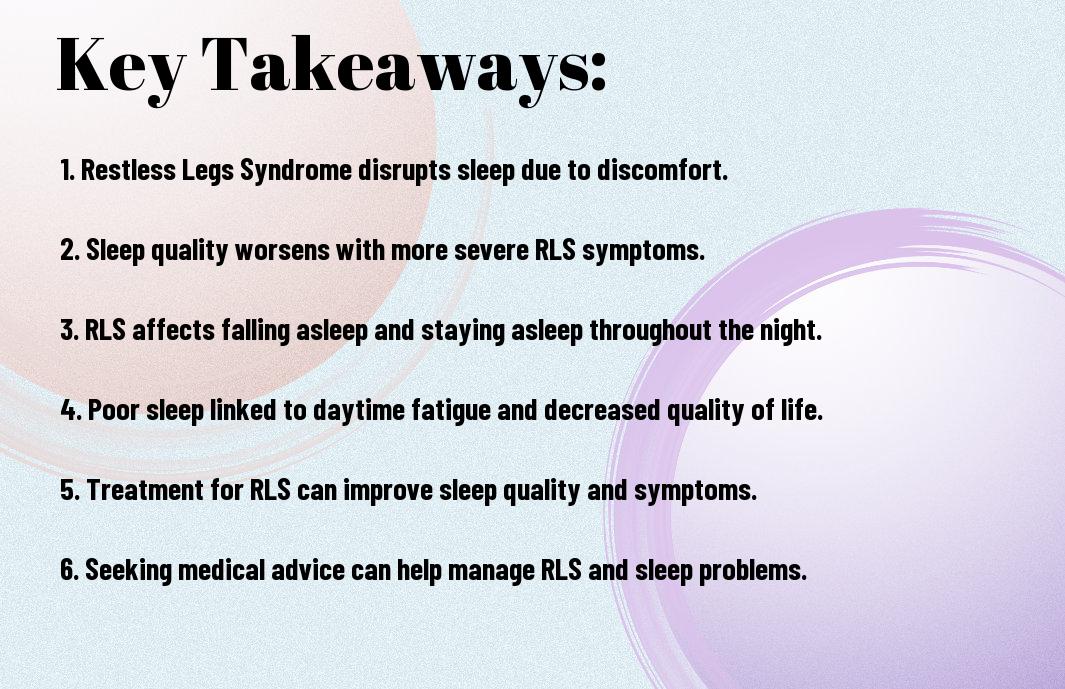This common yet often misunderstood condition can have a significant impact on one’s ability to get a good night’s sleep. Restless Legs Syndrome (RLS) affects millions of people, causing an uncontrollable urge to move the legs, especially during periods of rest or inactivity. The discomfort and restlessness experienced can lead to frequent awakenings, overall sleep disruption, and ultimately result in daytime fatigue and reduced quality of life. Understanding the relationship between RLS and sleep quality is crucial in finding effective management strategies to improve sleep for those living with this condition.
Key Takeaways:
- Restless Legs Syndrome (RLS) can significantly impact sleep quality, leading to difficulties falling and staying asleep.
- People with RLS may experience an overwhelming urge to move their legs when lying down or trying to relax, which can disrupt sleep patterns.
- The discomfort caused by RLS symptoms can result in fragmented sleep, leading to daytime fatigue and impaired cognitive function.
- Treating RLS through lifestyle changes, medication, and other therapies can improve sleep quality and overall well-being.
- Managing stress, establishing a bedtime routine, and creating a restful sleep environment can help minimize RLS symptoms and promote better sleep.
- It is essential for individuals with RLS to seek medical advice and support to develop a personalized treatment plan for improving sleep quality.
- By addressing RLS symptoms and prioritizing good sleep hygiene, individuals can enjoy better rest and enhanced quality of life.
Pathophysiology of Restless Legs Syndrome
Even though Restless Legs Syndrome (RLS) has been recognized for many years, the exact cause of this condition is still not fully understood. RLS is believed to have a multifaceted pathophysiology involving neurological, genetic, and environmental factors.
Neurological Basis of RLS
Pathophysiology studies have shown that RLS is related to abnormalities in the dopamine neurotransmitter system in the brain. Dopamine plays a crucial role in regulating movement and muscle activity. In individuals with RLS, there is a dysfunction in the dopamine pathways, leading to disturbances in the control of movement and sensations in the legs.
Furthermore, alterations in iron metabolism in the brain have also been linked to RLS. Iron deficiency or abnormalities in the way iron is transported in the brain can disrupt the normal functioning of the dopamine system and contribute to the development of RLS symptoms.
Factors Contributing to RLS
There are several factors that can contribute to the development or worsening of RLS symptoms. These include genetic predisposition, certain medical conditions such as kidney failure or peripheral neuropathy, pregnancy, and the use of certain medications like antihistamines or antidepressants.
- Genetic predisposition
- Medical conditions
- Pregnancy
- Medications
The interaction of these factors with underlying neurological mechanisms can increase the likelihood of experiencing RLS symptoms. After identifying and addressing these contributing factors, the management of RLS can be more effective in improving sleep quality and overall quality of life for individuals with this condition.
- Genetic predisposition
- Medical conditions
- Pregnancy
- Medications
With a better understanding of the pathophysiology and contributing factors to RLS, healthcare providers can tailor treatment plans to address the specific needs of each individual. By addressing the underlying causes of RLS, patients can experience improved sleep quality and enhanced well-being.
RLS and Its Effects on Sleep
Obviously, Restless Legs Syndrome (RLS) can have a significant impact on the quality of sleep for those affected by it. The uncomfortable sensations experienced in the legs can make it difficult for individuals to relax and fall asleep, leading to disrupted sleep patterns and overall poor quality of rest.
Sleep Disturbance Patterns in RLS Patients
Any individual with RLS knows all too well the challenges of trying to get a good night’s sleep. The urge to move the legs can be overwhelming, especially when trying to rest, leading to frequent awakenings throughout the night. This fragmented sleep can result in daytime fatigue, irritability, and difficulty concentrating.
In addition to the physical discomfort caused by RLS, the constant movement and restlessness can also disrupt the normal sleep cycle, preventing individuals from reaching the restorative stages of deep sleep. This can further exacerbate the daytime symptoms associated with RLS and lead to a vicious cycle of sleep deprivation and increased RLS symptoms.
The Relationship Between RLS Severity and Sleep Disruption
Sleep disturbances in RLS patients are often closely related to the severity of their symptoms. Sleep quality tends to deteriorate as the severity of RLS increases, with more frequent and intense leg movements leading to greater disruptions in the sleep cycle. It is crucial for individuals with RLS to address their symptoms and seek appropriate treatment to improve both their sleep quality and overall well-being.
Management of Restless Legs Syndrome
For individuals suffering from Restless Legs Syndrome (RLS), managing the condition is crucial in improving their sleep quality and overall well-being. There are various strategies and treatments available to help alleviate the symptoms of RLS and promote better sleep.
Non-Pharmacological Interventions
For those looking to explore non-pharmacological options, lifestyle changes can often make a significant difference in managing RLS symptoms. Regular exercise, particularly activities that promote relaxation such as yoga or tai chi, can help reduce the severity of symptoms. Avoiding caffeine, nicotine, and alcohol close to bedtime may also lead to improvements in sleep quality for individuals with RLS. Additionally, practicing good sleep hygiene, such as maintaining a consistent sleep schedule and creating a comfortable sleep environment, can contribute to better rest.
Pharmacological Treatments and Their Impact on Sleep Quality
On some occasions, non-pharmacological interventions may not provide sufficient relief for RLS symptoms, and medications may be necessary. Several medications are commonly used to manage RLS, including dopamine agonists, anticonvulsants, and opioids. These medications work by either increasing dopamine levels in the brain or altering other brain chemicals to help reduce the urge to move the legs. While these pharmacological treatments can be effective in alleviating RLS symptoms and improving sleep quality, it is essential to work closely with a healthcare provider to determine the most suitable medication and dosage for each individual’s needs.
Treatments for RLS should be individualized based on the severity of symptoms, underlying health conditions, and potential side effects of medications. Regular monitoring and adjustments to the treatment plan may be necessary to optimize outcomes. It is crucial for individuals with RLS to communicate openly with their healthcare providers about their symptoms and treatment preferences to ensure the most effective management of the condition.
Living with RLS
To truly understand the impact of Restless Legs Syndrome (RLS) on sleep quality, it is important to research into the daily struggles that individuals with RLS face. From the constant urge to move their legs to the sleep disruptions caused by RLS symptoms, living with this neurological disorder can be incredibly challenging and exhausting.
Daily Life and Coping Mechanisms
For those living with RLS, daily life can be significantly affected by symptoms such as discomfort, twitching, and the irresistible urge to move their legs. These symptoms often exacerbate during the evening and night, making it difficult to relax and fall asleep. To cope, individuals may try various strategies such as incorporating regular physical activity, practicing relaxation techniques, and maintaining a consistent sleep schedule to minimize the impact of RLS on their daily routine.
Moreover, individuals with RLS may find relief through medication prescribed by their healthcare provider, which can help manage symptoms and improve sleep quality. Developing a personalized coping strategy that combines lifestyle changes with medical interventions is essential for effectively managing RLS and enhancing overall well-being.
Long-Term Considerations and Quality of Life Issues
Mechanisms Long-term considerations for individuals with RLS involve not only managing the immediate symptoms but also addressing the potential long-term effects on quality of life. Untreated RLS can lead to chronic sleep deprivation, daytime fatigue, and increased risk of mental health issues such as anxiety and depression.
This underscores the importance of early diagnosis and comprehensive management of RLS to mitigate its impact on daily life and overall well-being. By taking a proactive approach to addressing RLS symptoms and prioritizing healthy sleep habits, individuals can work towards improving their quality of life and achieving better sleep outcomes.


To wrap up
The impact of Restless Legs Syndrome on sleep quality is significant, as it can cause disruptions to both falling asleep and staying asleep. This can lead to daytime fatigue, mood disturbances, and a decreased quality of life. Seeking medical evaluation and treatment options can help manage the symptoms of RLS and improve overall sleep quality. It is important to raise awareness about RLS and its effects on sleep to ensure proper diagnosis and management for those affected.
FAQ
Q: What is Restless Legs Syndrome (RLS)?
A: Restless Legs Syndrome (RLS) is a neurological disorder characterized by an uncontrollable urge to move the legs, usually due to uncomfortable or unpleasant sensations.
Q: How does RLS impact sleep quality?
A: RLS can severely impact sleep quality by causing difficulty falling asleep, frequent nighttime awakenings, and overall disrupted sleep patterns.
Q: What are the common symptoms of RLS?
A: Common symptoms of RLS include an urge to move the legs, uncomfortable sensations in the legs, worsening of symptoms at night, and relief with movement.
Q: How is RLS diagnosed?
A: RLS is typically diagnosed based on a thorough medical history, physical examination, and assessment of symptoms in accordance with established diagnostic criteria.
Q: What are the treatment options for RLS to improve sleep quality?
A: Treatment options for RLS may include lifestyle changes, medication therapy, iron supplementation, and managing underlying conditions contributing to symptoms in order to improve sleep quality.



